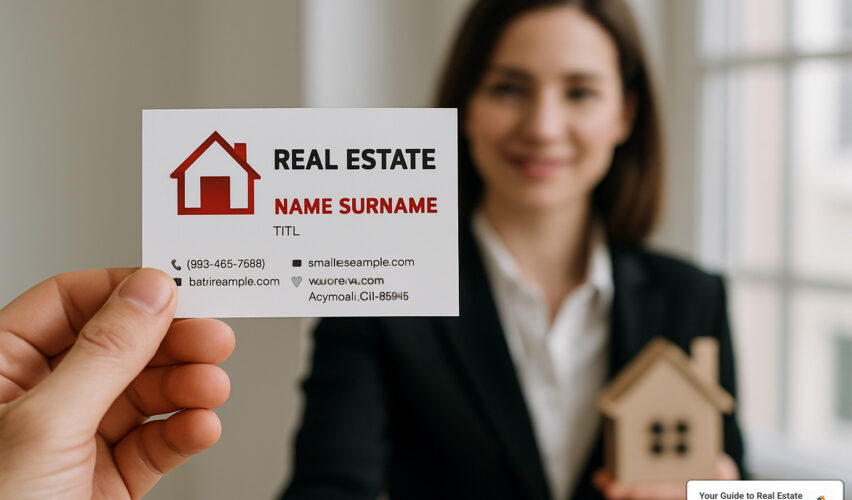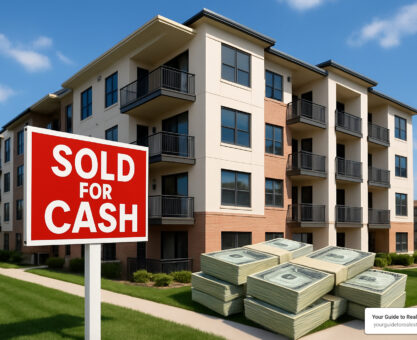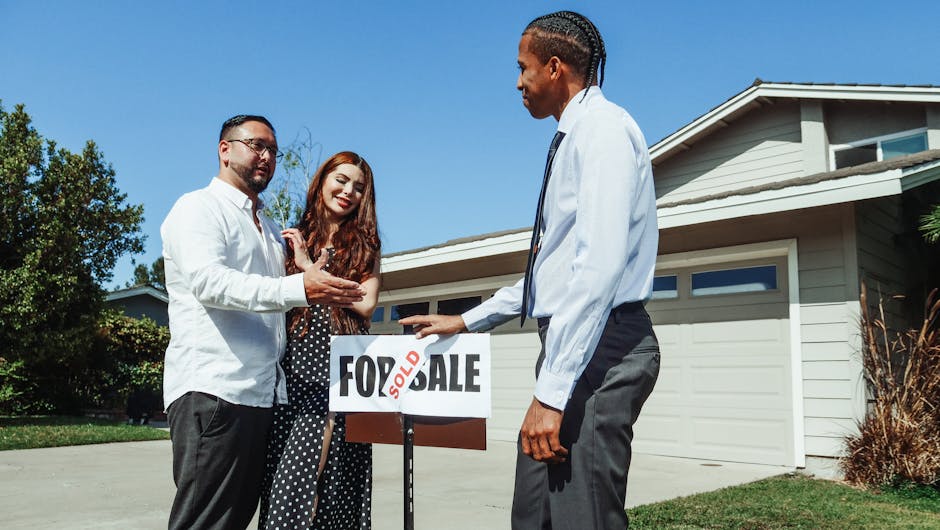Why Real Estate Business Cards Remain Your Most Powerful Deal-Making Tool
Real estate business cards are small but mighty tools that can close deals before you even pick up the phone. When everything feels digital, these pocket-sized marketing pieces create instant trust and memorable first impressions that smartphones simply can’t match.
Essential Elements for Effective Real Estate Business Cards:
- Name and professional title (Realtor, Agent, Broker)
- High-quality headshot for instant recognition
- Multiple contact methods (phone, email, text)
- QR code linking to listings or contact info
- Company logo and branding for credibility
- Professional finish (matte, gloss, or luxury stock)
The numbers tell the story: most real estate business card orders ship within 24-72 hours and cost as little as $0.05 per card for bulk orders. Yet these tiny investments generate referrals, open house leads, and listing appointments that can be worth thousands.
Whether you’re networking at community events, conducting listing presentations, or meeting potential buyers at open houses, your business card serves as a tangible reminder of your professionalism. It’s the one marketing piece that prospects will keep, share, and reference when they’re ready to make a move.
Modern real estate cards go far beyond basic contact info. Today’s top-performing agents include QR codes for instant digital connections, premium finishes that feel expensive, and strategic design elements that reinforce their personal brand.

Why Business Cards Still Matter in 2024
You might think real estate business cards are old-fashioned in our smartphone-obsessed world. But here’s the thing—while everyone else is going digital-only, smart agents are using that to their advantage.
There’s something magical about handing someone a beautiful, well-designed card. It creates tangible trust in a way that swapping phone numbers just can’t match. When a potential client feels the weight of quality cardstock between their fingers, they’re already forming an opinion about how you handle business.
Think about it: when was the last time you forgot about a business card sitting on your kitchen counter? Cards become pocket billboards that keep working long after you’ve left the conversation. They sit in wallets, get pinned to bulletin boards, and—most importantly—get shared with friends and family who might need your services.
The post-pandemic networking landscape has actually made business cards more valuable, not less. After years of virtual meetings, people crave authentic, in-person connections. A thoughtful card exchange feels refreshingly human in our digital-heavy world.
Even Gen-Z buyers appreciate the intentionality of a physical card. It shows you’re prepared, professional, and serious about your business. Plus, with most agents going digital-only, you’ll stand out simply by having something tangible to offer.
Psychological Impact of Hand-Offs
The moment you extend your card with genuine eye contact, something powerful happens. You’re creating what psychologists call a micro-commitment—that person is now holding a piece of your business in their hands.
This triggers the reciprocity principle without being pushy. When someone accepts your card, they feel a subtle obligation to at least consider what you’re offering. It’s not manipulation; it’s basic human psychology working in your favor.
Your card becomes a memory anchor that helps prospects remember you days or weeks later. While they might forget your name or mix up which agent they met where, that physical card with your smiling headshot brings the entire conversation flooding back.
The tactile experience matters more than you might expect. A well-designed card signals attention to detail—exactly what clients want in their real estate agent. More info about Real Estate Agent Skills can help you maximize these psychological advantages during every client interaction.
Situations Where Cards Close Deals
Real estate business cards aren’t just networking tools—they’re deal-closers in specific situations where digital exchanges fall flat.
Open houses are prime card territory. Visitors expect to take something with them, and your card might be the only thing that helps them remember you among the five other properties they’re seeing that weekend. Make sure yours stands out.
Door knocking campaigns become instantly more professional when you have a crisp card to leave behind. It transforms you from “some agent who stopped by” to a local professional worth remembering.
Those unexpected coffee shop chats can turn into goldmines when you’re prepared. The conversation naturally shifts to real estate, and suddenly you’re not just a friendly stranger—you’re someone with a business card and expertise to back it up.
During listing presentations, leaving behind a premium card reinforces everything you’ve just discussed. It gives sellers something tangible to reference when they’re making their decision later that evening.
Community events are where cards really shine. Whether you’re sponsoring a local sports team or attending a neighborhood barbecue, having cards lets you network naturally without seeming pushy or overly sales-focused.
Real Estate Business Cards: 2024 Design Trends & Ideas
The world of real estate business cards is experiencing a creative renaissance in 2024, with agents embracing bold design choices that help them stand out in increasingly competitive markets. Gone are the days of plain white cards with basic black text—today’s top performers are using strategic design elements that reflect their personality while building instant trust with prospects.
Color blocking has emerged as one of the hottest trends this year. Agents are incorporating their brand colors into geometric patterns and sections that create visual interest without making the card feel cluttered. This approach works particularly well for agents who want to reinforce their brand identity while keeping essential information easy to read.
Portrait layouts are gaining serious momentum, especially among agents who understand that real estate is fundamentally a relationship business. These vertical formats give your professional headshot the prominence it deserves while providing more space for contact information. The result feels modern and magazine-like—a refreshing change from traditional horizontal designs.

Minimalist luxury continues to dominate the high-end market, with successful agents choosing clean typography and generous white space to convey sophistication. There’s something powerful about a card that doesn’t try too hard—it suggests confidence and professionalism that prospects find reassuring.
Matte black cards with metallic foil accents are particularly popular among luxury market agents. These premium finishes create an immediate impression of quality and exclusivity. Meanwhile, holographic elements are adding an eye-catching shimmer that’s impossible to ignore, though they work best when used sparingly as accent pieces rather than dominant features.
The shift toward vertical formats isn’t just about aesthetics—it reflects how people naturally hold and view cards. Portrait-oriented designs are easier to read and more likely to be kept. As a bonus, they also photograph better for social media, extending your card’s reach beyond the initial recipient when clients share your information with friends and family.

Choosing Information to Include on Real Estate Business Cards
Your card’s information hierarchy should feel natural and logical, leading with your name and professional headshot as the primary focal points. These elements work together to create instant recognition and trust—two crucial factors in real estate success.
Follow up with your title and company affiliation to establish credibility. Don’t forget to include your real estate license number if your state requires it. This small detail adds legitimacy and ensures you’re staying compliant with local regulations.
Contact information deserves careful thought. Include your primary phone number and specify if it’s SMS-enabled for text communication. Add your email address and website URL, making sure both are current and professional. Many successful agents also include their social media handles, particularly Instagram and LinkedIn, to connect with tech-savvy clients who prefer these platforms.
A compelling call-to-action can transform your card from a simple contact tool into an active lead generator. Phrases like “Text me for instant property alerts” or “Scan for exclusive listings” give recipients a specific reason to contact you immediately rather than filing your card away for “someday.”
QR codes have moved from novelty to necessity in 2024. Position yours prominently but ensure it doesn’t compete with your headshot for attention. The code should link to something valuable—your website, current listings, or a digital business card that’s always up-to-date.
Best Practices for Real Estate Business Cards That Convert
Effective card design follows visual hierarchy principles that guide the reader’s eye naturally from your most important information to supporting details. Your name and photo should receive the most prominent placement, followed by contact information and your call-to-action.
Font readability is non-negotiable. Stick to fonts sized at least 8 points and ensure sufficient contrast between text and background colors. Many of your prospects may be older adults who struggle with small or low-contrast text.
White space is your friend—it makes your card feel premium and prevents information overload. Resist the temptation to cram every possible detail onto your card. If prospects want more information, they’ll contact you.
Maintain consistency with your existing brand palette and marketing materials. Your business card should feel like a natural extension of your website, social media presence, and other promotional pieces. This consistency builds trust and reinforces your professional image.
Consider A/B testing different designs by ordering small quantities and tracking which versions generate more responses. Some agents find that including property photos or local market statistics on the back of their cards increases engagement and provides natural conversation starters.
More info about Choosing a Real Estate Broker can help you understand how your card design should align with your brokerage’s brand guidelines while still showcasing your individual personality and style.
Real Estate Business Card Templates & Inspiration
Modern templates recognize that headshot focus is essential in real estate. The most effective designs feature large, high-quality photos that help prospects remember and trust you. Your face should be the hero of your card design—everything else is supporting information.
Icon sets for phone, email, and social media create visual interest while making contact information easier to scan quickly. The best agents choose minimalist icon designs that complement rather than compete with their professional photography.
Luxury tri-layer cards are gaining traction among high-end market agents who understand that tactile experience matters. These premium options cost more upfront but create unforgettable first impressions that often justify the investment through higher-value client relationships.
For fresh ideas and proven templates, explore resources like Real Estate Business Cards Print Design Gallery, Free Real Estate Business Card Design Templates to see what’s working for successful agents across different markets and price points.
Materials, Finishes & Sustainability Choices
The moment someone touches your real estate business cards, they’re forming an opinion about your professionalism. That’s why choosing the right cardstock feels so important—it’s literally the foundation of your first impression.
Premium cardstock starts at 14-point thickness, which feels solid without being bulky. Most successful agents find that 16-point stock hits the sweet spot between professional quality and reasonable cost. When you hand someone a card with good weight, they instinctively know you’re serious about your business.
Linen texture adds that sophisticated touch that makes people want to run their fingers over your card. It’s subtle but memorable. Suede touch coating takes things up a notch—it’s so smooth and luxurious that prospects often comment on how good it feels.
If you care about the environment (and many clients do too), recycled stock manufactured with wind power gives you a great story to tell. These eco-friendly options often spark conversations about your values, which can be exactly the connection you need with environmentally conscious buyers and sellers.
The finish you choose completely changes how your card looks and feels. Matte laminate cuts down on glare and fingerprints while giving your card excellent durability. Gloss UV coating makes colors pop and creates sharp contrast that catches the eye. For pure luxury, soft-touch velvet coating delivers that premium feel that screams success.
| Thickness | Cost Range | Durability | Best For |
|---|---|---|---|
| 14-pt Matte | $0.05-0.10 | Good | New agents, bulk networking |
| 16-pt Gloss | $0.15-0.25 | Excellent | Most professional situations |
| 32-pt Triple | $1.00-3.00 | Premium | Luxury market agents |
Budget-Friendly vs. Luxury Stocks
Starting agents often worry about card costs, but 14-point matte cardstock at around $0.05-0.10 per card delivers professional results without breaking the bank. It’s thick enough to feel substantial and durable enough for everyday networking.
16-point gloss stock costs a bit more at $0.15-0.25 per card, but the difference in perceived quality is immediately noticeable. That extra thickness and glossy finish often pays for itself when prospects keep your card instead of tossing it.
For agents working luxury markets, 32-point triple-layer cards or even metal and wood options can cost $1-5 per card. Yes, that sounds expensive until you remember that one referral from an impressed client can generate thousands in commission. The ROI per card becomes obvious when you think about it that way.
The math is simple: if a premium card helps you close just one additional deal per year, it’s paid for itself hundreds of times over.
Green Options That Impress Clients
100% recycled cardstock with FSC certification tells clients you care about responsible business practices. These cards look and feel just as professional as traditional options while supporting sustainable forestry.
Soy inks create vibrant colors without the environmental impact of petroleum-based alternatives. Most clients won’t notice the difference in appearance, but environmentally aware prospects often ask about your printing choices.
Carbon-neutral shipping adds minimal cost while letting you honestly say your business cards have zero net environmental impact. This resonates especially well with younger buyers who research companies’ environmental policies before doing business.
These green credentials become powerful conversation starters. When clients see you making thoughtful environmental choices in something as simple as business cards, they trust you’ll bring that same consideration to their real estate decisions.
Smart Tech: QR Codes and Digital Integrations
The magic happens when your real estate business cards become bridges between the physical and digital worlds. QR codes have transformed from those quirky black squares into powerful tools that instantly connect prospects to your listings, contact information, or appointment booking systems.
Think of your QR code as a tiny portal to your best content. When someone scans it, they should land somewhere valuable—maybe your most stunning property photos, a neighborhood market report, or a simple calendar where they can book a coffee meeting. The goal is making that scan feel worth their time.
NFC chips are the next level up from QR codes. These tiny tech marvels let someone tap their phone to your card and instantly save your contact details. They cost more than QR codes, but the seamless experience feels almost magical to clients who’ve never seen it before.
Some forward-thinking agents are experimenting with augmented reality features that bring their cards to life. Imagine a prospect pointing their phone at your card and seeing a 3D virtual tour of your latest listing pop up on their screen. It’s not science fiction anymore—it’s happening right now.
Analytics tracking turns your business card into a mini marketing campaign. You can see exactly how many people scan your code, when they do it, and what they look at afterward. This data helps you understand which networking events actually generate interest and which ones are just free appetizers.
How to Add and Track a QR Code
Dynamic QR codes are your best friend because you can change where they lead without printing new cards. Got a hot new listing? Update your QR code to showcase it. Hosting an open house? Point the code to your event page. This flexibility makes your cards evergreen marketing tools.
The beauty of scan metrics lies in the insights they provide. You’ll find that the QR code you handed out at the neighborhood barbecue gets scanned more than the ones from that expensive networking mixer. Data like this helps you focus your time where it actually pays off.
Color contrast matters more than you might think. Black codes on white backgrounds scan reliably every time, while fancy colored codes might look pretty but frustrate people trying to scan them. Always leave enough white space around your code—that “quiet zone” prevents scanning errors that make you look unprofessional.
Before you print a thousand cards, test your QR codes with different phones and apps. What works perfectly on your iPhone might struggle on your client’s Android, and you’ll never know until you test it. More info about Build Real Estate Business covers how QR codes fit into your bigger marketing picture.
Hybrid Networking Etiquette
The most effective networking today combines the trust-building power of physical cards with the convenience of digital connections. Hand someone your card while simultaneously connecting on LinkedIn or exchanging numbers for texting. This paper plus digital synergy keeps you top-of-mind through multiple channels.
The scan-then-save approach works beautifully with younger prospects who manage their entire lives digitally. Encourage them to scan your QR code right there in front of you, then explain what cool stuff they’ll find when they visit. This immediate engagement shows your tech-savviness while ensuring they actually use the code.
Text follow-ups within 24 hours work like magic. Reference your in-person meeting and provide something valuable—maybe a market report for their neighborhood or alerts for properties matching their criteria. This quick digital follow-up transforms a business card exchange into the beginning of a real relationship.
Smart agents are finding that the combination of premium physical cards and seamless digital integration creates the perfect first impression. You’re showing prospects that you understand both traditional relationship-building and modern technology—exactly what they want in their real estate business cards and their agent.
Ordering, Printing & Budget Tips

Getting your real estate business cards printed has never been easier, thanks to user-friendly online design platforms that put professional results within every agent’s reach. These browser-based editors offer hundreds of real estate-specific templates, so you don’t need to be a graphic designer to create cards that look like they cost a fortune.
The beauty of modern printing services lies in their flexibility. You can order as few as 50 cards to test a new design or go big with 1,000+ cards to maximize your bulk savings. Most platforms offer pricing that drops dramatically as quantities increase—jumping from 100 to 500 cards often cuts your cost per card in half.
Need cards for tomorrow’s networking event? Many printers offer same-day production for orders placed by 12 PM Pacific Time. Rush shipping options can get your cards in hand within 1-2 business days, though you’ll pay premium rates for the convenience.
Smart agents take advantage of bulk pricing that can bring costs down to just $0.05 per card for large orders. Even premium finishes and specialty papers become surprisingly affordable when you’re ordering 500 or more cards.
Team coordination makes bulk ordering even more powerful. When your entire brokerage orders together, everyone benefits from volume discounts while maintaining consistent branding across the team.
Step-by-Step Online Ordering Workflow
Starting your card order feels overwhelming until you break it down into simple steps. Choose your template first, focusing on designs that match your market positioning—luxury layouts for high-end agents, clean modern designs for contemporary markets, or traditional styles for established neighborhoods.
Upload your professional headshot in the highest resolution possible, ideally 300 DPI or higher. Your photo will be the most important element on your card, so don’t skimp on quality here. Most platforms accept JPG or PNG files, and many offer cropping tools to get your positioning just right.
Insert your contact information carefully, triple-checking every phone number and email address. It’s heartbreaking to receive 500 beautiful cards with a typo in your phone number. Take your time here—most platforms offer spell-check features that catch common mistakes.
Review your digital proof like your business depends on it, because it does. Check text alignment, color accuracy, and overall balance. This is your last chance to catch errors before production begins, so examine every detail carefully.
Select your paper stock based on your budget and target market. Standard 14-point cardstock works well for most agents, while 16-point premium stock creates a more luxurious feel that justifies the modest price increase.
Choose your quantity strategically. New agents might start with 250-500 cards to manage startup costs, while established agents often order 1,000+ cards to maximize bulk savings and ensure they never run out during busy networking periods.
Complete checkout and request tracking information so you know exactly when your cards will arrive. Most orders ship within 24-72 hours and arrive within a week of placement.
Coordinating Team & Brokerage Branding

Smart brokerages use centralized design systems that keep everyone on-brand while allowing individual personality to shine through. These platforms typically lock in your corporate colors, fonts, and logos while giving agents freedom to customize their photos and contact details.
The magic happens when teams coordinate their ordering schedules. Bulk discount programs can slash costs by 30-50% compared to individual orders, making premium finishes affordable for everyone. Instead of each agent paying $0.20 per card, team orders might bring costs down to $0.10 per card or less.
Centralized reordering simplifies life when agents need updates. Whether you’re adding a new certification, changing your phone number, or simply running low on cards, most platforms save your design and allow quick reorders with minimal changes.
The key is establishing locked brand elements that maintain consistency across your team while providing variable agent fields for personalization. This approach ensures that whether prospects receive cards from you or your colleague, they experience the same professional brand image that builds trust and recognition in your market.
Frequently Asked Questions about Real Estate Business Cards
Why are real estate business cards still crucial in a digital age?
Real estate business cards remain powerful because they create something smartphones can’t replicate—genuine human connection. When you hand someone your card, you’re making eye contact, sharing a smile, and creating a moment that sticks in their memory long after your conversation ends.
The psychology is fascinating. That physical exchange triggers what experts call the reciprocity principle. When someone accepts your card, they feel a small obligation to at least consider your services. It’s like a tiny handshake agreement that digital contacts just don’t create.
Think about your own wallet or purse. You probably have business cards tucked away from people you met weeks or months ago. Those cards serve as constant reminders, sitting there waiting for the perfect moment when you or someone you know needs that service. That’s marketing gold that no app notification can match.
In real estate, where trust drives every transaction, having something tangible reinforces your legitimacy. It shows you’re established, professional, and planning to stick around—qualities that matter when someone’s making the biggest financial decision of their life.
What’s the ideal size, paper weight, and finish for real estate cards?
The sweet spot for real estate business cards is the standard 3.5″ x 2″ size that fits perfectly in wallets and business card holders. Going bigger might seem attention-grabbing, but it often backfires when prospects can’t store your card properly and end up tossing it.
For paper weight, 14-16 point cardstock hits the perfect balance between durability and cost. Anything thinner feels flimsy and cheap, while ultra-thick stocks create storage problems and can actually work against you. Your card should feel substantial but not bulky.
Matte finishes win for readability and professional appearance. They eliminate glare under office lights and give your card a sophisticated, modern feel. Gloss finishes work beautifully if your design features vibrant photos or bold colors that you want to pop, but they can show fingerprints and scratches more easily.
The key is matching your finish to your market. Luxury agents might splurge on soft-touch coatings or specialty papers, while new agents can create impressive results with quality matte cardstock that doesn’t break the budget.
How much should I budget for 500 premium cards with QR codes?
Plan to invest $75-150 for 500 premium cards with QR codes, depending on your paper choice and finish preferences. This might seem like a significant expense when you’re starting out, but consider the math: if those cards generate just one listing or buyer client, they’ve paid for themselves dozens of times over.
The price range reflects different quality levels. Basic premium cards with QR codes start around $75, while luxury options with specialty finishes can reach $150 or more. Most successful agents find the sweet spot around $100-125 for cards that look and feel expensive without breaking the budget.
QR codes don’t typically add extra costs—most modern printing services include them as standard features. The real cost drivers are paper thickness, special finishes, and quantity. Ordering 1,000 cards instead of 500 often reduces your per-card cost significantly.
Many agents find that investing in quality cards actually saves money long-term. Cheap cards get thrown away or forgotten, while premium cards get kept, shared, and remembered. When you’re building a referral-based business, that difference in retention can be worth thousands in future commissions.
Conclusion
Your real estate business cards are more than just pieces of paper—they’re your silent sales team working 24/7 to grow your business. When you combine thoughtful design with premium materials and smart technology, these pocket-sized marketing tools become powerful relationship builders that turn chance encounters into closed deals.
The magic happens when you carry them everywhere and use them strategically. That casual conversation at the grocery store, the neighbor you meet while walking your dog, or the parent you chat with at your kid’s soccer game—these everyday moments become business opportunities when you have a professional card ready to share.
Think of your card as your first impression in physical form. Before you even speak, it communicates your professionalism, attention to detail, and market positioning. A luxury agent needs a card that feels as premium as their service, while a first-time buyer specialist might choose a more approachable, friendly design.
The real power comes from blending old-school networking with modern technology. Hand someone your card, watch them scan your QR code, and follow up with a text within 24 hours. This hybrid approach builds trust through personal connection while keeping you top-of-mind through digital engagement.
Every card you distribute is an investment in your future business. Whether it sits on someone’s kitchen counter for months or gets tucked into a wallet for years, your card continues working long after you’ve forgotten about that initial handshake.
The most successful agents treat their cards like seeds—they plant them everywhere and nurture the relationships that grow from those first exchanges. Your card might be the reason someone calls you instead of the agent down the street when they’re ready to make their move.
More info about Agents’ resources can help you integrate business cards into your broader marketing strategy. At Your Guide to Real Estate, we empower agents with up-to-date strategies to turn simple cards into deal-closing machines that work around the clock to grow your business.





















